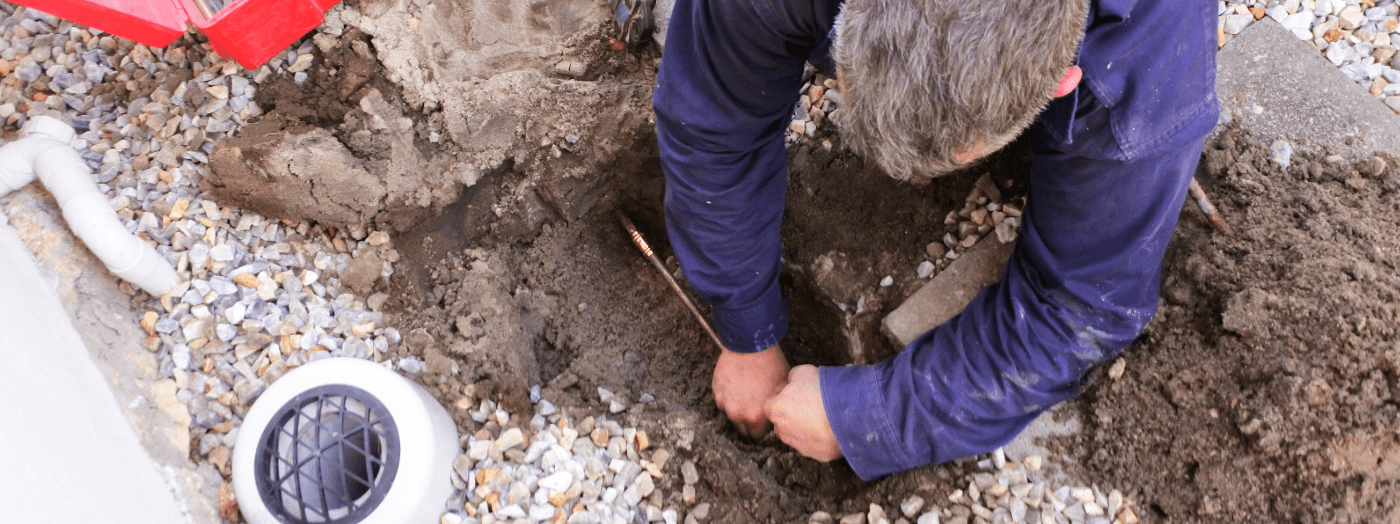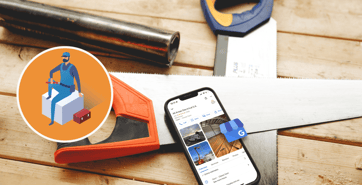How to Become a Plumber in Australia
by Team Tradify, June 17, 2024

Table of Contents
There are plenty of reasons to become a plumber in Australia, including job stability, career growth, high wages and the opportunity to build a career that allows you to take charge of your life or even start your own plumbing business. To become a plumber in Australia, you need to complete an apprenticeship, pass your plumbing certificates, gain a Construction Induction Card, commonly known as a White Card, and then register with your local state licensing authority. Later on, if you’re keen to gain specialist skills, further studies such as a Certificate IV in Plumbing and Services can help you on your way.
Already licensed or registered plumber? Check out how the following guides to grow your plumbing career:
- How to Start a Plumbing Business
- Your Guide to Plumbing Industry Associations
- How to Be a Good Plumber
- Tradie Hourly Rates State By State
Ready to supercharge your plumbing business? Try Tradify free for 14 days!
Low on time? Skip ahead!
- Plumbing certifications to become a plumber in Australia
- Types of qualified plumbers in Australia
- How to become a plumber in VIC (Victoria)
- How to become a plumber in WA (Western Australia)
- How to become a plumber in NSW (New South Wales)
- How to become a plumber in SA (South Australia)
- How to become a plumber is TAS (Tasmania)
- How to become a plumber in NT (Northern Territory)
- Plumbing apprenticeship jobs in Australia
1. Plumbing certifications to become a plumber in Australia
Becoming a plumber requires a mix of hands-on and theoretical training. Your theoretical training will take place in a registered facility, such as a technical institute or university.
To start your training to become a plumber in Australia, you must first meet the following qualifications.
- You have to be at a minimum of 18 years of age.
- You must have completed your high school education and be comfortable with your knowledge of mathematics.
Before gaining your license or becoming registered, you will need the following certificates to work as a plumber in Australia:
Certificate II in Plumbing
Designed to give you a clear indication of core plumbing skills and knowledge, a Certificate II in Plumbing (Pre-apprenticeship) prepares you for a plumbing apprenticeship.
Certification III in Plumbing
A Certificate III in Plumbing (Apprenticeship) trains you over five streams of plumbing: drainage, gas, roofing, sanitary and water — with an option to choose to study the mechanical stream. As part of your certificate, you will also learn to weld polymer pipes using the fusion method. Many offer this certificate on both a full or part-time basis, depending on how quickly you wish to be qualified versus how many hours you can commit to training. You may become a registered plumber after completing this certificate.
Certificate IV in Plumbing
A Certificate IV advanced certification program provides the theoretical and practical knowledge needed to qualify for a plumbing license, alongside growth in skills such as leadership and sustainable work practices. This certificate in required to become a licensed plumber.
2. Types of qualified plumbers in Australia
In Australia, you can become either a registered or licensed plumber, depending on your level of study and experience. Registered plumbers can do most of the same work as licensed plumbers, but licensed plumbers have more knowledge, training and experience. Licensed plumbers can also supervise other plumbers and apprentices. To become licensed, you must complete a Certificate IV in Plumbing and Services, gain practical experience, and pass a state or territory licensing exam.
Registered plumber
Qualifications:
- Has completed necessary training and certification (e.g., Certificate III in Plumbing).
Work scope:
- Can work in the main classes of plumbing.
- Cannot work in specialised classes of plumbing without further certification.
Supervision:
- Can supervise apprentices.
- Cannot sign compliance certificates.
Licensed plumber
Qualifications:
- Has completed advanced training and certification (e.g., Certificate IV in Plumbing and Services).
- Has met state or territory-specific licensing requirements, including passing a licensing exam.
Work scope:
- Can work in both main and specialised classes of plumbing.
Supervision:
- Can supervise apprentices.
- Can supervise registered plumbers.
- Can sign compliance certificates.
3. How to become a plumber in VIC (Victoria)
Step 1: Pre-apprenticeship
The pre-apprenticeship is a 16-week course providing basic plumbing skills, including welding, sheet metal, roofing, drainage, sanitary, water, and gas principles. Students can gain first-hand industry experience while earning a Certificate II in Plumbing. This step is preferred by most employers for new apprentices.
Step 2: Apprenticeship
Your apprenticeship is a 4-year working agreement designed in order for you to learn practical skills on the job, whilst also studying. This includes completing the nationally accredited Certificate III in Plumbing. You must first find a licensed plumbing practitioner to mentor you.
Step 3: Registration
After completing your apprenticeship, you must pass an exam and submit your apprenticeship paperwork to the Victorian Building Authority. Upon success, you will receive a registration card with a practitioner number, allowing you to work in the main classes of plumbing based on your apprenticeship focus.
4. How to become a plumber in WA (Western Australia)
Step 1: Pre-apprenticeship
Your pre-apprenticeship is your opportunity to learn basic plumbing skills, including welding, sheet metal, roofing, drainage, sanitary, water, and gas principles, within a 16-week course. After earning a Certificate II in Plumbing, you are better suited for a full-time plumbing apprenticeship in Western Australia.
Step 2: Apprenticeship
A 4-year apprenticeship is required to become a plumber, during which you must be employed in an apprenticeship arrangement. Under Western Australian law, this must be a Certificate II or higher (Plumbers Licensing Act 1995). Successful completion of an apprenticeship enables students to then apply for a Western Australian Plumbing Tradespersons License with the Department of Mines, Industry Regulation and Safety (DMIRS).
Step 3: Registration
After completing your apprenticeship, you must pass an exam and submit your apprenticeship paperwork to the Western Australia: Plumbers Licensing Board or Office of Energy. You will then receive a registration card with a practitioner number, allowing you to work in the main classes of plumbing based on your apprenticeship focus.
5. How to become a plumber in NSW (New South Wales)
Step 1: Pre-apprenticeship
Students of the pre-apprenticeship 16-week course will learn basic plumbing skills; including welding, sheet metal, roofing, drainage, sanitary, water, and gas principles. After gaining first-hand industry experience, students will earn their Certificate II in Plumbing.
Step 2: Apprenticeship
Your apprenticeship is a 4-year working agreement designed for you to learn practical skills on the job, whilst also studying for a Certificate III in Plumbing. You must first find a licensed plumbing practitioner to mentor you.
Step 3: Registration
To acquire a plumbing license in NSW, you must submit an application form, a checklist, and proof of completed training to NSW Fair Trading. If you plan to carry out specialised tasks, such as installing backflow prevention devices or working on Type B gas appliances, you must ensure your license covers these areas. Additionally, to obtain a plumbing contractor license, you need to demonstrate at least two years of practical experience and complete a Certificate IV in Plumbing and Services.
6. How to become a plumber in SA (South Australia)
Step 1: Pre-apprenticeship
To prepare for an apprenticeship, students should complete a 16-week course that provides them with basic plumbing skills, including welding, sheet metal, roofing, drainage, sanitary, water, and gas principles. This first-hand industry experience, in part of earning a Certificate II in Plumbing.
Step 2: Apprenticeship
A 4-year apprenticeship is required to become a plumber, during which you must be employed in an apprenticeship arrangement. This includes completing the nationally accredited Certificate III in Plumbing.
Step 3: Registration
After completing your apprenticeship, you must pass an exam and submit your apprenticeship paperwork to The Office of Consumer and Business Affairs in South Australia. After passing the exam, you will receive a registration card with a practitioner number, allowing you to work as a plumber, within the main classes of plumbing you included in your apprenticeship.
7. How to become a plumber is TAS (Tasmania)
Step 1: Pre-apprenticeship
The pre-apprenticeship is a 16-week course that teaches essential plumbing skills such as welding, sheet metal work, roofing, drainage, and the basics of sanitary, water, and gas systems. During this course, students gain practical industry experience and earn a Certificate II in Plumbing. This qualification is often favoured by employers when hiring new apprentices.
Step 2: Apprenticeship
A 4-year apprenticeship is required to become a registered or licensed plumber, during which you must be employed in an apprenticeship arrangement. This includes completing the nationally accredited Certificate III in Plumbing and working with a licensed plumber.
Step 3: Registration
After completing your apprenticeship, you must pass an exam and submit your apprenticeship paperwork to Workplace Standards Tasmania. After passing the exam, you will receive a registration card with a practitioner number, allowing you to work as a plumber, within the main classes of plumbing you included in your apprenticeship.
8. How to become a plumber in NT (Northern Territory)
Step 1: Pre-apprenticeship
The pre-apprenticeship is a 16-week program that teaches essential plumbing skills such as welding, sheet metal work, roofing, drainage, sanitary systems, water, and gas principles. During this course, students gain practical industry experience and earn a Certificate II in Plumbing. Most employers prefer candidates who have completed this step before starting an apprenticeship.
Step 2: Apprenticeship
To become a registered or licensed plumber, you need to complete a 4-year apprenticeship while being employed in an apprenticeship arrangement. This process involves earning the nationally recognized Certificate III in Plumbing and gaining hands-on experience under the supervision of a licensed plumber.
Step 3: Registration
After completing your apprenticeship, you must pass an exam and submit your apprenticeship paperwork to the Northern Territory Plumbers and Drainers Licensing Board. Upon passing the exam, you will be issued a registration card with a practitioner number, enabling you to work as a plumber in the primary plumbing areas covered during your apprenticeship.
9. Plumbing apprenticeship jobs in Australia
Ready to get started? Apprenticeships provide the hands-on experience and practical skills necessary to become a great plumber.
To begin, research and apply to plumbing apprenticeship programs in your area. These programs are designed to offer both on-the-job training and formal education, ensuring you gain comprehensive knowledge and experience. Here are some valuable resources to help you find the right apprenticeship opportunities:
- How to Get a Plumbing Apprenticeship
- How to Be A Good Plumbing Apprentice
- MEGT Job Board
- Seek: Plumbing Apprenticeship Jobs
- Apprenticeship Careers: Plumbing Apprenticeship
Tradify is a job management app used by thousands of tradespeople building better lives and businesses all over the world. It gives you all the features needed to manage and grow a successful trade business, including:
Start your 14-day free trial today. No credit card required. No pressure. Or take a look at Tradify in action during one of our weekly 30-min live walkthroughs.
Related articles

Quick Quotes Mean More Jobs for Sharp Air Conditioning

How To Set Up a Google Business Profile (for Trade Businesses)

Aussie Electrician Reduces Admin Time by 95%
Give Tradify a go for free!
Save 10+ hours/week on business admin with the highest-rated job management software for tradespeople.
With free one-on-one training and phone support, it's never been easier to get started.



